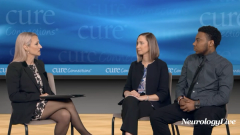
Multidisciplinary Management and Educational Support
Episodes in this series

Philippa Cheetham, MBChB, MRCS, MD, FRCS: Now we've heard about all these novel therapies that were available with astounding success. Obviously, you're not working in isolation. You're working as a multidisciplinary team. How do you work with physical therapists to optimize the improvement that you can see in building muscle strength with exercise, lifestyle? What advice do you give to patients to maximize the performance outcome from this boosted muscle function?
Crystal Proud, MD: Sebastian can tell you we have incredibly rigorous clinical days, so when he comes for an appointment, how long do you think you're there? Two hours?
Sebastian Mills: You know I like to stay and talk.
Crystal Proud, MD: Yes, that's true. He's chatty. So, probably a minimum 2 hour appointments, and that's because of this multidisciplinary team that you've referred to. A physical medicine and rehabilitation specialist is present, a physical therapist, occupational therapist, respiratory therapists, we’re monitoring spirometry measurements. We have an SMA [spinal muscular atrophy] dietitian in clinic because nutrition is so incredibly important. We have a social worker, an educational liaison who helps us communicate the needs of our patients to schools. We have a variety of different individuals, including my nurse coordinators, who help to try to make it so that medical appointments do not become your life, that we can try and consolidate to the best that we can. And so, it really is an incredible team approach to be able to maintain and optimize the lives of our patients.
Philippa Cheetham, MBChB, MRCS, MD, FRCS: You've talked about nutrition. Can you elaborate a little bit on the role of nutrition, diet, lifestyle in the management of this disease because we're talking about muscle function? What kind of advice do you give patients in terms of nutrition? And why is nutrition such a big problem for patients with this disease?
Crystal Proud, MD: Right now, there is not a clinically or a scientifically tested diet that is technically recommended. There is still more research that needs to be done into that. But nutrition is incredibly important for patients with SMA. We find that with our younger children, they may be at risk of what's called failure to thrive, where they cannot gain appropriate weight. And that's probably because they're working so hard to keep up with others that their metabolism is just incredibly hard and incredibly high within their muscles. We see that the opposite may happen, actually, in our adult patients, where it may be difficult for them to lose weight, especially if they have limited mobility. For my patients who cannot walk and are utilizing wheelchairs and power wheelchairs, their ability to burn calories is so very different. And so, they may be at risk of being overweight. My nutritionist really has to span that entire gap and be able to help to supplement the needs of our kids with failure to thrive and then be able to help try to modify some of the diets of our older patients who may be at risk of being overweight.
Philippa Cheetham, MBChB, MRCS, MD, FRCS: Sebastian, do you feel kind of isolated, having had a diagnosis that's quite a rare diagnosis that most people have never heard of? Does that make you feel nervous when you talk to other doctors who may go, “Oh, I don't even know what that is, or I've not heard of it?”
Sebastian Mills: In the beginning, it did because I honestly didn't know anybody else who had it. But through Dr Proud, they were able to put these groups together where you're able to meet people even of your age who have the same diagnosis. You're able to form bonds and relationships and actually talk about things that you might not have been able to talk about before. And when you go see these doctors, now you're able not only to be more educated because of what Dr Proud has told me, but also become more comfortable having conversations about it.
Philippa Cheetham, MBChB, MRCS, MD, FRCS: Right, and now with access to the internet and social media, are you a member of any SMA groups, or are there any particular websites or resources that you think are helpful for parents and families who may be starting off on this journey looking into treatment options for spinal muscular atrophy?
Sebastian Mills: Yes, I know you can look SMA up, as well as go to the website.
Crystal Proud, MD: CureSMA.org?
Sebastian Mills: Yes, there's a CureSMA.org website, and it gives you a bunch of information. And even when you see Dr Proud for the first time, she gives you a pamphlet, and a packet, and a booklet—she gives you a lot of information as well. And there's actually a kit, too, that comes with everything that breaks it down. Like she said, her pictures that she draws that break it down, it gives you a bunch of information to take in and be able to understand and communicate, “Okay, from now on, I know what steps we need to take.”
Crystal Proud, MD: Absolutely. The largest resource comes in the form of CureSMA. That is the organization that supports patients and families impacted by spinal muscular atrophy. And there's an annual conference, both for patients, families, caregivers, and clinicians every year. There is a website dedicated to this organization, CureSMA.org. It has resources for families. It has resources for diagnosis. It has identified areas where treatment is being offered. And it will actually keep people updated on some of the new treatments that may be coming available in the future and research opportunities. So it's a great resource for anyone.
Newsletter
Keep your finger on the pulse of neurology—subscribe to NeurologyLive for expert interviews, new data, and breakthrough treatment updates.


















